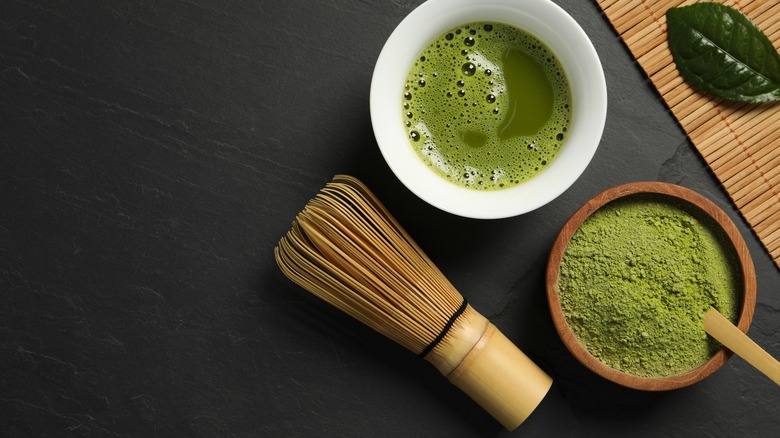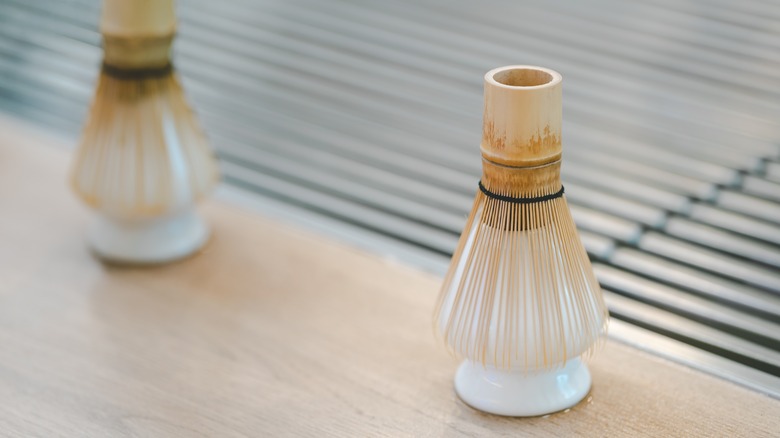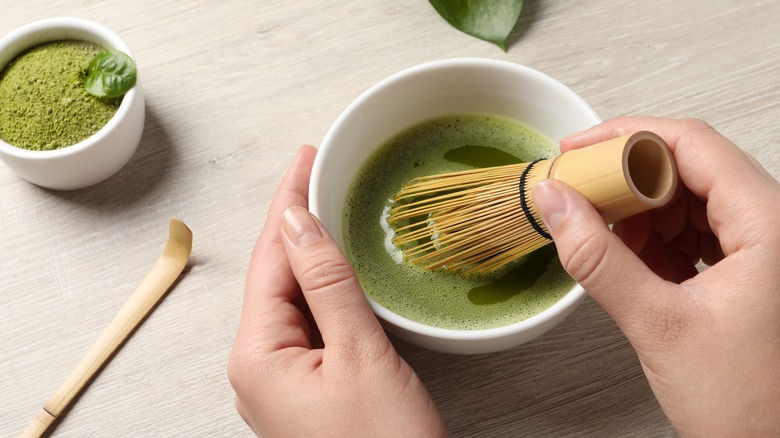The One Thing You Should Never Do When Cleaning A Matcha Whisk
A good cup of matcha depends on many factors. The quality and quantity of the tea itself matters as does the temperature and ratio of the water used. An important (and often overlooked) element is the bamboo whisk (also called a chasen) that's used to mix the drink together.
A damaged whisk can leave your matcha lumpy, whereas a low-quality tool can impart a stale and chemical-like flavor and odor into the drink. Not cleaning the whisk can also impair its efficiency and its ability to make a foamy, frothy matcha; it could also cause mold. Besides, not taking care of a chasen can reduce its lifespan significantly — and who wants to be buying a new matcha whisk every few months?
This is why it's important to properly care for your whisk, which includes taking note of what not to do when cleaning it. One of the biggest don'ts is using soap to wash it, or popping it in the dishwasher. A chasen typically lasts for a year or two before it needs to be replaced, but the harshness of soaps and dishwashers can shorten this drastically.
Additionally, bamboo can absorb the flavor and smell of soap, which it will then impart into future matcha. So unless you want your drink tasting like dishwashing liquid, it's best to avoid it when cleaning a chasen. It's the same reason why you would never use soap to clean stained wine decanters either.
The best way to clean a matcha whisk
The dainty design of a chasen can make it seem like a complex tool to clean, but it really isn't. All you need to do is soak the whisk in warm water and then rinse it until all traces of tea wash away — it's as quick and easy as that. Make sure to do so as soon as you've used the chasen though, before the matcha dries and hardens into stubborn grime. Additionally, consider spiking the warm water with white vinegar if you notice patches of discoloration or fuzzy mildew on the chasen. You could even use a toothbrush to gently get in between those bristles if they seem particularly dirty.
Once the whisk is clean, place it back on its holder so that the bristles can keep their shape as they dry. No matter what you do, don't leave the chasen upside down on its handle. This will cause water to pool there and it can lead to mold. Don't lay the whisk on its side either, as this can damage its shape beyond repair.
Give the whisk another warm water soak before you use it. This will allow the bristles to soften, bloom, and become more flexible, which is what will give you that fabulously frothy matcha. While this cleaning process normally only takes a couple of minutes, you'll want to give the chasen a longer soak if it's brand-new and about to be used for the very first time.
How to use a clean chasen to make matcha
Once your chasen is clean, it's time to whisk together your foamy cup of matcha. The first step is to add the tea powder to the chawan (a ceramic bowl used to prepare matcha) and then pour hot water over it. Use your chasen to gently swirl the mixture until the powder has dissolved smoothly into the liquid. Then, it's time to whisk to make that desired froth.
The trick is to hold the whisk loosely by its handle and use your wrist rather than your fingers to do the whisking. Hold the chawan firmly with one hand and use the other to rapidly rotate the chasen in a back-and-forth zigzag motion, as if you're forming the shape of the letter W. Keep whisking quickly and vigorously this way, and you'll start to see your frothy matcha come together in a matter of seconds.
A few things to be careful about when making matcha with a bamboo whisk is to make sure that the tool is suspended in the liquid and not touching the bottom of the ceramic bowl. You also don't want to be too forceful — hitting the bowl or whisking too aggressively can damage those bamboo bristles and break them. Granted, a couple of broken bristles won't be the end of the world for your matcha whisk, but the damage will only increase with time until you're eventually forced to replace the tool.



